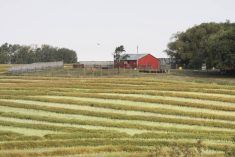The industry managed to save its season last year in Alberta and Manitoba, but Saskatchewan was not as fortunate
The 2021 Thoroughbred racing season is headed for the starting gate.
Last year, the pandemic forced prairie horse racing to change its gait, but most venues stayed on track and some exceeded their financial expectations.
“We had our best (betting) handle year in many years and we raced right through until the first week of November,” said Norm Castiglione, president of the Horseman’s Benevolent and Protective Association of Alberta.
He said training had already started for A level Thoroughbreds when COVID-19 forced the shutdown March 15. Grade 1 is the top level of the three graded stakes tiers: 1, 2, and 3.
Read Also

Nutritious pork packed with vitamins, essential minerals
Recipes for pork
“We were already on the grounds of Century Mile Racetrack training. So when they locked everything down, we just backed up the start of racing. We obviously shortened the number of days we were able to race, but had a pretty successful season,” said Castiglione.
Even with 20 fewer race days last year, he said about $10 million more was bet at Century Mile Racetrack than in 2019. Owned by Century Casinos, the Edmonton track is one of two A-level horse-racing venues in the province and the only one-mile racetrack in Western Canada.
“Bettors weren’t allowed to go to their favourite tracks because everything was closed except for the odd track throughout North America, at least for a long period of time.”
Castiglione said a change in time for their Sunday races at Century Mile proved successful because they didn’t compete with large online betting tracks in the United States.
“We learned you’ve got to be in the right time slot to be available for the big betting areas. Some of these big tracks bet in one day almost what we’ve done in an entire year. So it’s better if you can stay after their day of racing is over or get there before their day of racing,” he said.
“Some of our biggest bet races were our last races of the day, the seven, eight and nine races.”
Assiniboia Downs in Winnipeg also refocused operations because spectators were no longer allowed and track restaurants and access to VLT machines were closed.
“Dramatically would be the word that comes to mind relative to having to essentially reinvent the business model to capture interest and revenue without spectators,” said Darren Dunn, chief executive officer of Assiniboia Downs.
“We were quickly able to establish we would not have spectators on site and we went into heavy strategy and promotion relative to selling our racing signal worldwide.”
With one of the more robust legal wagering platforms in Canada, Dunn said they recognized that all 2020 revenue would be online.
“What we needed to do was pivot to try and open new accounts within the province, and then open new sales opportunities worldwide, relative to trying to sell our live racing signal to markets outside of Manitoba and Canada.”
The gross wagering for the season surpassed all records.
In 2019, total wagering at Assiniboia Downs was $12,467,854 on 50 race days. Wagering on 50 race days in 2020 was $63,263,947.
Dunn said tracks retain only a small percentage of those totals but betting volume helped offset losses from inaccessible VLT play, food and beverage revenue and facility rentals.
Like Alberta’s two A-level horse racing venues, (Century Mile Racetrack and Casino in Edmonton and Century Downs Racetrack and Casino near Calgary) Assiniboia Downs also changed its racing schedule, switching from weekends to Monday, Tuesday and Wednesday.
“That was strategic to sell that racing signal against the backdrop of less competition,” said Dunn.
With spring training now under way, he said that model will continue this year. Opening day is May 17.
Dunn said acquiring international jockeys has been a major challenge. Many come from the United States and the border remains closed to non-essential travel.
Dunn and Castiglione said they are optimistic that 2022 will see a meaningful return of spectators and the opening of restaurants and VLTs.
“I think we’re poised for a good start and if we can keep the numbers down, we’ll actually see spectators again in our business. There’s a pent-up demand for that, both from the people that own horses to the racetracks, to have spectators back and get the excitement of horse racing back at the track again,” said Castiglione.
Online betting will also continue at both tracks.
“The model we incorporated saved our racing season last year, without a doubt, when there was a point when all bets were off and there was a lot of unknown and uncertainty,” said Dunn.
Added Castiglione: “The silver lining was we didn’t have to shut down and that people survived through the whole thing. Had we not been able to function last year and again this year, I suspect horse racing would’ve gone the same way in Alberta as it did in Saskatchewan.”
That was a reference to recent announcements that races at Marquis Downs in Saskatoon’s Prairieland Park will be cancelled for the second year in a row and will be permanently replaced by professional soccer.
The decision will affect hundreds of horse owners and a host of support personnel, including trainers, farriers and veterinarians in Saskatchewan.
“Had the pandemic not happened, I don’t think we’d be where we are today,” said Colleen O’Hagan, who used to train more than 20 horses and runs a boarding stable in Saskatoon.


















